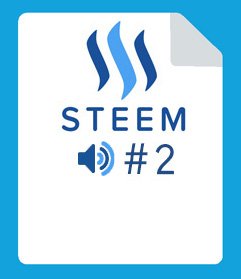Steem Audio WhitePaper (Part 2): Ways to Contribute

Ways to Contribute
This section outlines the ideas behind Steem and its rewards for people who provide meaningful and measurable contributions to the Steem community.
Capital Contributions
There are two items a community can offer to attract capital: debt and ownership. Those who buy ownership profit when the community grows but lose if the community shrinks. Those who buy debt are guaranteed a certain amount of interest but do not get to participate in any profits realized by the growth of the community. Both types of capital contributions are valuable to the growth of the community and value of its currency. Additionally there are two ways ownership can be held: liquid and vesting. Vesting ownership makes a long-term commitment and cannot be sold for a minimum period of time.
The Steem network calls these different asset classes Steem (STEEM), Steem Power (SP), and Steem Dollars (SMD).
Steem (STEEM)
Steem is the fundamental unit of account on the Steem blockchain. All other tokens derive their value from the value of STEEM. Generally speaking STEEM should be held for short periods of time when liquidity is needed. Someone looking to enter or exit the Steem platform will have to buy or sell STEEM. Once STEEM has been purchased it should be converted into SP or SMD to mitigate the impact of dilution over the long-term.
STEEM is constantly increasing in supply by 100% per year due to non-SMD incentives. Someone who holds STEEM without converting it to SP is diluted by approximately 0.19% per day. While the rate may appear high, for transactions that take less than 10 days, it is still cheaper than credit card processing fees. Furthermore, the daily token creation is insignificant next to the daily volatility. Someone who buys Bitcoin or any other cryptocurrency and sells it 10 days later could easily lose 3% or more due to price fluctuations. Someone who buys Bitcoin and then sells it the same day will usually pay more than 0.4% in market fees alone. In other words, the inflation rate is effectively insignificant during the period of time the typical individual will hold STEEM. The majority of inflation is actually an accounting artifact rather than true reallocation of wealth. 90% of non-SMD inflation is distributed back to existing holders of STEEM proportional to the STEEM value of their SP balance, making inflation more of a “split”. Only about 10% of non-SMD inflation redistributes ownership in the network.
Steem Power (SP)
Start up companies require long-term capital commitment. Those who invest their money in a startup expect to wait years before they can sell their shares and realize their profits. Without long-term commitment, a startup seeking to raise additional capital through the sale of additional shares would be competing with existing shareholders looking to exit. Savvy investors want their capital contributions to grow the company, but growth cannot happen if the new capital is given away to those looking to exit. There is significant value to having long-term commitment because it enables communities to make long-term plans. Long term commitment of stakeholders also causes them to vote for long-term growth rather than short-term pumps.
In the cryptocurrency space, speculators jump from cryptocurrency to cryptocurrency based mostly on which one is expected to have short-term growth. Steem wants to build a community that is mostly owned and entirely controlled by those with a long-term perspective. Because Steem wants to encourage long-term growth, it is hardwired to allocate 9 STEEM to Steem Power (SP) stakeholders for every 1 STEEM it creates to fund growth through contribution incentives. Over time this drives the ratio of the total STEEM value of Steem Power balances to the total of STEEM balances toward 9:1 . (It seems likely that the ratio will be somewhat greater than 9:1 due to continued net Powering Up of the newly printed STEEM.) It also means that long-term holders are almost completely protected from the dilution used to fund growth.
SP can only be converted back to STEEM over 2 years via 104 equal weekly payments. ‘1 SP’ can be viewed as a share in a pool of STEEM. The network automatically adds STEEM to the pool every block. At any time users can convert their STEEM into SP at the same ratio as STEEM in the vesting pool to total SP. Converting STEEM to SP does not dilute existing holders of SP. Likewise, every time SP is converted back to STEEM it is done at the current ratio. Individuals are guaranteed to have more STEEM in the future than they have when they first convert from STEEM to SP. SP balances are non-transferrable and non-divisible except via the automatically recurring conversion requests. This means that SP cannot be easily traded on cryptocurrency exchanges. SP is a requirement for voting for or against content. This means that SP is an access token that grants its holders exclusive powers within the Steem platform.
Transferring from STEEM to SP is referred to as powering up while transferring from SP to Steem is referred to as “powering down.” For example, one can power down their STEEM over a period of two years, yet one can power up their STEEM instantly.
Steem Dollars (SMD)
Stability is an important feature of successful global economies. Without stability, individuals across the world could not have low cognitive costs while engaging in commerce and savings. Because stability is an important feature of successful economies, Steem Dollars were designed as an attempt to bring stability to the world of cryptocurrency and to the individuals who use the Steem network.
Steem Dollars are created by a mechanism similar to convertible notes, which are often used to fund startups. In the startup world, convertible notes are short-term debt instruments that can be converted to ownership at a rate determined in the future, typically during a future funding round. A blockchain based token can be viewed as ownership in the community whereas a convertible note can be viewed as a debt denominated in any other commodity or currency. The terms of the convertible note allow the holder to convert to the backing token with a minimum notice at the fair market price of the token. Creating token-convertible-dollars enables blockchains to grow their network effect while maximizing the return for token holders. Steem Dollars are referred to with the symbol SMD, an acronym for Steem Dollars. Creating SMD requires a combination of a reliable price feed, rules to prevent abuse, and liquidity. Providing a reliable price feed involves three factors: minimizing the impact of an incorrect feed, maximizing the cost of producing an incorrect feed, and minimizing the importance of timing.
Minimizing Fraudulent Feeds
SP holders elect individuals to publish price feeds. These elected individuals are presumably trusted by those who have a vested interest in the quality of the feed. By paying those who are elected, Steem creates market competition to earn the right to produce feeds. The more the feed producers are paid the more they have to lose by publishing false information. Given a set of trusted and elected feed producers, the actual price used for conversions can be derived as the median of the feeds. In this way if any minority of individual feed producers produce outliers they have minimal impact on the actual median while still having the ability impact their reputation. Even if all feed producers are honest, it is possible for the majority of feed producers to be impacted by events beyond their control.
The Steem network is designed to tolerate short-term corruption of the median price feed while the community actively works to correct the issue. One example of an issue that may take some time to correct is short-term market manipulation. Market manipulation is difficult and expensive to maintain for long periods of time. Another example would be the failure of a centralized exchange or the corruption of the data published by the exchange. Steem factors out short-term price fluctuations by using the median price over a period ofone week. The median published feed is sampled every hour on the hour. As long as the price feed corruption lasts for less than half the moving median time window it will have minimal impact on the conversion price. In the event the feed does get
corrupted, network participants will have an opportunity to vote-out corrupt feed producers before the corrupted feed can impact the actual conversion price. Perhaps more importantly, it gives feed producers an opportunity to detect and correct issues before their feeds start impacting the price. With a one week window, community members have three and a half days to respond toany issues that come up.
Mitigating Timing Attacks
Market participants have access to information faster than the blockchain’s one week moving median conversion price can react. This information could be used to benefit of traders at the expense of the community. If there is a sudden increase in the value of STEEM traders could request conversion of their SMD at the old, lower price, and then sell the STEEM they receive a the new higher price with minimal risk. Steem levels the playing field by requiring all conversion requests to be delayed for one week. This means that neither the traders nor the blockchain has any information advantage regarding the price at the time the conversion is executed.
Minimizing Abuse of Conversions
If people could freely convert in both directions then traders could take advantage of the blockchains conversion rates by trading large volumes without changing the price. Traders who see a massive run up in price would convert to SMD at the high price (when it is most risky) and then convert back after the correction. The Steem protocol protects the community from this kind of abuse by only allowing people to convert from SMD to STEEM
and not the other way around. The blockchain decides how and when to create SMD and who should get it. This keeps the rate of SMD creation stable and removes most avenues of abuse.
Liquidity (Liquidity Rewards have been halted since the creation of this document)
Just because SMD can be converted to a dollars worth of STEEM at a fair price in a reasonable amount of time doesn’t mean it will be viewed as a reliable dollar replacement. These assets require liquidity in a market that enables instantaneous conversion between STEEM and SMD. The measures a blockchain is forced to take to prevent abuse end up lowering the quality of the convertible dollars. To compensate for this loss of quality the
blockchain can offer a fixed cost reward to liquidity providers. Whereas the potential losses from manipulation and abuse are unbounded, the cost of encouraging liquidity can be fixed. A liquidity provider buys and sells SMD and STEEM. They take on the majority of the short-term price risk and long-term feed risk giving the remaining market participants a high quality, extremely liquid market within which to trade. Steem has an on-blockchain market between SMD and STEEM. Users can earn rewards by providing liquidity to both sides of this market. The blockchain uses a simple algorithm to rank each user’s liquidity provision and consumption.
A user is considered a liquidity provider if they leave an open order on the books for at least 1 minute and the order is eventually filled. If the order is canceled before being filled then the user is not credited with providing liquidity.
Users must provide liquidity on both sides of the book to qualify for rewards and they must provide liquidity consistently over time.
The scoring algorithm is:
LiquidityPoints = NetBidVolume x NetAskVolume
Every hour the account with the most LiquidityPoints receives 1200 STEEM and then has its LiquidityPoints reset to 0. An account that goes a week without earning any LiquidityPoints also has its points reset to 0. This means that whether you provide a large amount of liquidity or a small amount over a long period of time everyone gets a proportional amount of the rewards. If either NetBidVolume or NetAskVolume is negative, then LiquidityPoints is
considered to be 0.
Sustainable Debt to Ownership Ratios
If a token is viewed as ownership in the whole supply of tokens, then a token-convertible-dollar can be viewed as debt. If the debt to ownership ratio gets too high the entire currency can become unstable. Debt conversions can dramatically increase the token supply, which in turn is sold on the market suppressing the price. Subsequent
conversions require the issuance of even more tokens. Left unchecked the system can collapse leaving worthless ownership backing a mountain of debt. The higher the debt to ownership ratio becomes the less willing new investors are to bring capital to the table.
For every SMD Steem creates, $19.00 of STEEM is also created and converted to SP. This means that the highest possible debt-to-ownership in a stable market is 1:19 or about 5%. If Steem falls in value by 50% then the ratio could increase to 10%. An 88% fall in value of STEEM could cause the debt-to-ownership ratio to reach 40%. Assuming the value of STEEM eventually stabilizes, the debt-to-ownership ratio will naturally move back toward
5%.
The idea behind having a conservative 5% debt to ownership ratio is that even if all debt were converted and sold there should be ample buyers and the effective dilution of the token holders remains relatively small. A rapid change in the value of STEEM can dramatically change the debt-to-ownership ratio. The percentage floors used to compute STEEM creation are based on the supply including the STEEM value of all outstanding SMD and SP (as determined by the current rate / feed).
Interest
SMD pays holders interest. The interest rate is set by the same people who publish the price feed so that it can adapt to changing market conditions. All debt carries risk to the lender. Someone who holds SMD without redeeming it is effectively lending the community the value of a dollar. They are trusting that at some point in the future someone will be willing to buy the SMD from them for a dollar or that there will be speculators and investors willing tobuy the STEEM they convert it into.
STEEM and SP holders gain leverage when members of the community are willing to hold SMD. This leverage amplifies the gains from growth while also contributing to growth. STEEM holders do suffer from increased dilution if the price falls. Cryptocurrency projects have shown that the gains from increasing the user base willing to trust the network with capital ultimately add more value to the network than any dilution that may occur during a
downturn.
Setting Price Feeds
Astute readers will recognize that an interest bearing asset of limited supply may trade higher or lower than the underlying asset depending upon other opportunities to earn interest on the same asset. With a high interest rate paid on an asset pegged to the US dollar many people will bid up the limited supply of Steem Dollars until they are no longer valued at $1. In economics there is a principle known as the Impossible Trinity which states that it is impossible to have all three of the following at the same time:
- A stable exchange rate
- Free capital movement
- An independent monetary policy
If Steem feed producers aim to have an independent monetary policy allowing it to create and destroy Steem Dollars while simultaneously having full control over the interest rate then they will encounter problems. The Impossible Trinity says that Steem Dollars either need to restrict capital movement, have an unstable exchange rate with the dollar, or have limited control over the interest rate.
The primary concern of Steem feed producers is to maintain a stable one-to-one conversion between SMD and the U.S. Dollar (USD). Any time SMD is consistently trading above $1.00 USD interest payments must be stopped. In a market where 0% interest on debt still demands a premium, it is safe to say the market is willing to extend more credit than the debt the community is willing to take on. If this happens a SMD will be valued at more than $1.00 and there is little the community can do without charging negative interest rates. If the debt-to-ownership ratio is under 10% and SMD is trading for less than $1.00 then the interest rate should be increased. This will encourage more people to hold their SMD and support the price.
If SMD trades for less than $1.00 USD and the debt-to-ownership ratio is over 10% then the feeds should be adjusted upward give more STEEM per SMD. This will increase demand for SMD while also reducing the debt-to-ownership ratio and returning SMD to parity with USD. Assuming the value of STEEM is growing faster than Steem is creating new SMD, the debt-to-ownership ratio should remain under the target ratio and the interest offered benefits everyone. If the value of the network is flat or falling, then any interest offered will only make the debt-to-ownership ratio worse.
In effect, feed producers are entrusted with the responsibility of setting monetary policy for the purpose of maintaining a stable peg to the USD. Abuse of this power can harm the value of STEEM so SP holders are wise to vote for witnesses that can be counted on to adjust the price feed and interest rates according to the rules outlined above.
If the debt-to-ownership ratio gets dangerously high and market participants choose to avoid conversion requests, then the feed should be adjusted to increase the rate at which STEEM paid for converting SMD. Changes to the interest rate policy and/or any premiums/discounts on the STEEM/SMD conversion rate should be a slow and measured response to long-term average deviations rather than attempting to respond to short-term market conditions. The blockchain is paying liquidity providers for their service in absorbing short-term demands. It is our belief that these rules will give market participants confidence that they are unlikely lose money by holding SMD purchased at a price of $1.00. We fully expect there to be a narrow trading range between $0.99 and $1.01 for SMD under most market conditions.
Look for Part 2.2 (Subjective Contributions) in the coming weeks.
The above is a link to the newly released Part 2 portion of STEEMs Audio version of the Whitepaper. Please feel free to pass this on to individuals who are asking deep questions about STEEM and how it can work but are highly unlikely to have the time or inclination to read it.
Or listen to it on a drive, while relaxing in a hammock or running on the treadmill. Anywhere you cannot/will not read, but still can use your ears...THIS whitepaper has been made for you! :)
The text above has been taken from www.steemit.io/whitepaper.pdf
All profits made from this whitepaper will be directed toward bringing the tipping of many cryptos to steemit. My work aims to help with the "whale problem" by giving other community's whales the ability to use their own tokens to gain influence over whales, dolphins and minnows alike in the steem ecosystem. Because we Care about the Long-Term viability for all humanity, this tipping will support creation of custom tokens for members of the steemit community who wish to back them with their own unique Value Propositions!
help us, help you...
nice post @officialfuzzy

Good job ..
Upvote done
cool post, @officialfuzzy

Hi @officialfuzzy thanks for voting my message to @cryptoctopus about requesting a vote for my invitation to my Belgian CEO who has a huge business network in Europe. Does it mean that you agree on my request? Can I expect your upvote too?
I erased the negative rep but please stop spamming your CEO story everywhere. People will upvote you when you post content of merit.
Thanks @smooth, so your a nice guy after all.
backsound/audio song at the beginning which was cool, but I think if you keep putting it until the final minutes will be more comfortable when I'm listening to every word. but still good :)
Thank you for your opinion. Should i make one with less music in it?
i like this @officialfuzzy

👍nice post and audio @officialfuzzy
Now this is some serious great work! Thanks for adding value to Steemit
Wow! An audio version of it is an excellent idea... Now I have to go and listen to the first part! Thank you so very much for this. All for one and one for all! Namaste :)
@officialfuzzy
Upvoted
Nice great to know!
The liquidity provider part is outdated (?) I think as the service has stopped (?) after the last fork.
Yes and because of this i omitted that portion :)